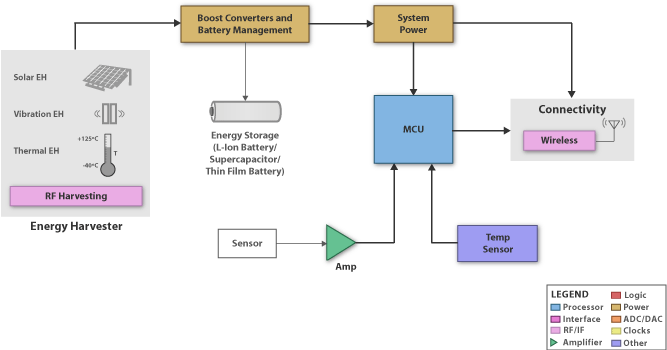
Design Considerations
Energy Harvesting (EH) also known as Energy scavenging is the use of ambient energy to provide electrical power for small electronic and electrical devices.
An Energy Harvesting System consists of an Energy Harvester Module and a processor/transmitter block. The Energy Harvester module captures milli-watts of energy from light, vibration, thermal or biological sources. A possible source of energy also comes from RF such as emitted from cell phone towers. The power is then conditioned and stored within a battery, an efficient quick charging capacitor or one of the newly developed thin film batteries. The system is then triggered at the required intervals to take a sensor reading, through a low power system. This data is then processed and transmitted to the base station. This kind of EH System eliminates the dependency of the system on battery power and reduces the need to service the system.
TI's TMS37157 could also be used to harness the RF energy into electrical energy. TI's MSP430 and Low Power RF parts combined with efficient DC/DC Converters and Battery Management parts are an ideal complement to these low power energy harvesting sources with as low as 160 uA/MHz (microamp per megahertz) active power consumption and 1.5 uA standby power consumption, MSP430F5xx MCUs enable longer battery life or no batteries at all for energy harvesting systems that run off of solar power, vibration energy or temperature differences like found on human body. The low start-up voltages of TPS612xx family enable start of Energy Harvesting at smaller voltages. TI's RF transceivers that operate in the 2.4-GHz/Sub 1-GHz range are well-suited for reliable digital wireless applications.
TI's USB-based eZ430-RF2500 tool provides hardware and software to program an MSP430 MCU and low power wireless transceiver on a postage stamp-sized target board.
By enabling 20+ year battery life, TI is opening the door to new applications that were not feasible with traditional battery powered systems. From powering a clock with a grape, to using vehicle vibrations to power sensors on a bridge, to solar powered sensors for wireless monitoring of a farm or winery, TI along with leading energy harvesting vendors, are creating a complete ecosystem allowing designers to not only envision but also create a battery-less world.
Advertisement

Learn more about Texas Instruments





